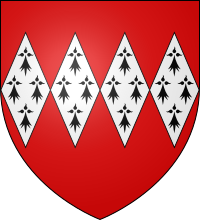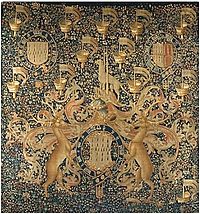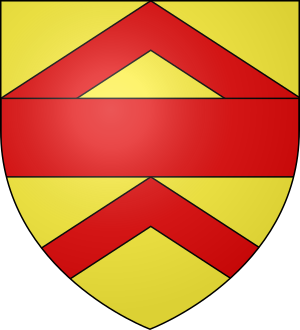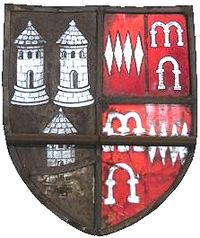John Dynham, 1st Baron Dynham facts for kids
Quick facts for kids
John Dynham
|
|
|---|---|

Arms of Dynham: Gules, four fusils in fess ermine
|
|
| Born | c. 1433 Nutwell, Devon |
| Died | 28 January 1501 Lambeth, Surrey |
| Resting place | London Greyfriars |
| Title | 1st Baron Dynham |
| Tenure | 1467–1501 |
| Offices | Lord High Treasurer of England Lord Chancellor of Ireland |
| Parents | John Dinham Joan Arches |
John Dynham, 1st Baron Dynham (around 1433–1501) was an important English nobleman and politician. He came from Nutwell and Hartland, both in Devon. He held important jobs like Lord High Treasurer of England and Lord Chancellor of Ireland. John Dynham was special because he was a trusted advisor to three different kings: Edward IV, Richard III, and Henry VII.
Contents
Who Was John Dynham?
John Dynham was born at Nutwell around 1433. He was the oldest son of Sir John Dinham and Joan Arches. His family, the Dynhams, had lived at Nutwell since about 1122. They were one of the most important families in Devon. John's father passed away in 1458. His mother, Joan, managed their lands until she died in 1497.
John Dynham's Career
John Dynham had a long and successful career in English politics. He served under different kings during a time of big changes in England.
Helping the Yorkist Kings
John Dynham first started working for the House of York in 1459. This was when the future King Edward IV and his relatives were in trouble. They were running away after a difficult battle. John's mother gave them a safe place to stay. John himself bought the ship they used to escape to Calais.
Because of his support, John was later declared an enemy by the Parliament. But he still led two successful attacks against the king's forces. In one attack, he captured a powerful lord named Baron Rivers. Baron Rivers was then made fun of for not being from a noble family. This was quite funny later, as Rivers' daughter would marry King Edward IV.
Working for King Edward IV
In 1460, John Dynham became the High Sheriff of Devon and Lord Chancellor of Ireland. After Edward IV became king, John joined the King's special advisors. In 1467, he was given the title of Baron Dynham. This meant he was a very important nobleman.
John stayed loyal to King Edward during difficult times between 1469 and 1471. After Edward returned to power, John became one of the most important people in the government. In 1475, he was the leader of the navy during a short war with France.
Even though he was important, the King didn't give him many new lands. His lands were mostly in Devon and Cornwall. John also didn't have many powerful family connections through marriage.
Serving King Richard III
When Richard III became king, John Dynham continued to do well. He became the leader of Calais, an important English town in France. In this role, he took back Hammes Castle, which had switched sides to support Henry VII. However, he was criticized for letting the soldiers leave safely.
His family connections became useful for a while. His sister, Joan, married John, Lord Zouche. Lord Zouche was becoming very important under King Richard. But his future was ruined after the Battle of Bosworth.
Under King Henry VII
After King Richard III died, John Dynham stayed in Calais. He waited to see if the new king, Henry VII, would be angry with him. But Henry VII actually wanted John's help. John had a history of being loyal to the Crown, which Henry valued.
John's new father-in-law, Lord Willoughby de Broke, was also very important to King Henry. This helped John's career even more. John became a Knight of the Garter, a very high honor. He was also the Lord High Treasurer from 1486 until he died. This meant he was in charge of the country's money. He took this job very seriously and spent most of his time in Lambeth to be close to the treasury.
He received many grants and served on many important groups. He was also one of the judges who tried the rebels after the Cornish Rebellion of 1497.
John's career did not suffer even when his stepson was accused of disloyalty in 1495. His brother-in-law, Lord Zouche, also lost his titles. But John was given money to help his sister, Lady Zouche. Lord Zouche was even allowed to return to favor later on.
John Dynham passed away at his home in Lambeth, Surrey, on January 28, 1501. He was buried in London Greyfriars. He didn't have any children who lived to adulthood. His three brothers had also died before him. So, his title ended when he died. One of his brothers, Oliver Dynham, was a church leader who died in 1500.
Family Life
John Dynham was married two times.

- His first wife was Elizabeth FitzWalter (1430–before 1485). She was the 8th Baroness FitzWalter in her own right. She had been married before to John Radcliffe. When she died, her lands went to her son from her first marriage.
- Around 1485, he married Elizabeth Willoughby (died before 1510). She was the daughter of Robert Willoughby, 1st Baron Willoughby de Broke. She outlived John and married again. John and Elizabeth had at least two children who died when they were young:
- George Dinham
- Philippa Dinham
John also had a son outside of marriage, named Thomas Dynham (died 1519). Thomas was given lands in Eythrope, Buckinghamshire. He married Joan Ormond.
What Happened to His Lands?
Since John Dynham had no children who lived, his lands went to the children of his four surviving sisters. His estates included places like Nutwell, Kingskerswell, Hartland, Devon, and Souldern.
- Margery Dinham (died 1471) was his oldest sister. She married Nicholas IV Carew.
- Elizabeth Dinham (died 1516) was his second sister. She married three times. Her first husband was Fulk Bourchier. Her second was Sir John Sapcotes. Her third was Sir Thomas Brandon.
- Joan Dinham was his third sister. She was the wife of John la Zouche, 7th Baron Zouche, 8th Baron St Maur.
- Katherine Dinham was his fourth sister. She married Sir Thomas Arundell. She was the mother of Sir John Arundell.
John also had another sister, Edith Dinham. She worked for Lady Margaret Beaufort, who was King Henry VII's mother. Edith died before John and had no children.
Dynham's Special Tapestry

There is a large, beautiful tapestry from Flanders that shows Lord Dynham's family symbols. It was made between 1497 and 1501. This tapestry is now in the Metropolitan Museum of Art in New York.
The tapestry was likely made by the Grenier family, who also made tapestries for King Henry VII. In 1488, King Henry VII told his Treasurer, Lord Dynham, to let these tapestries come into England without taxes. It's thought that Dynham might have ordered one for himself at the same time.
The main part of the tapestry shows a shield surrounded by a Garter. John Dynham received this special honor in 1487, which helps us know when the tapestry was made. The shield is held up by two deer. This is a clever way to show his connection to Hartland Abbey, one of his family's oldest properties.
In the top corners of the tapestry, there are more shields. One shows the Dynham family's symbols. The other shows the Dynham symbols combined with the Arches family symbols. These two shields represent Lord Dynham's father and mother.
The Dynham family's general symbol was a deer's head, again linked to Hartland Abbey. Lord Dynham's own special symbol was the top part of a warship. It had five spears and a flag with the Cross of St George. This personal symbol is shown many times on the tapestry.



